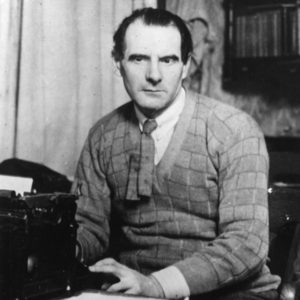
Beginning in 1914, Sean O’Casey was the Secretary of the Irish Citizens’ Army. Thus Young Indiana Jones portrays his patriotic side quite well, having him criticize the musical that portrays Irish stereotypes. He was very outspoken when it came to the rival group of the Citizens’ Army, the Irish Volunteers. However, he was always a bit critical of his own organization as well. He “…found it extremely difficult to come to an understanding with J.R. White, the president of the I.C.A., and Countess Markievicz, the treasurer,” as Sean O’Casey The Man Behind the Plays puts it. Eventually, he was forced to resign because of the Countess. She had somewhat sided with the Irish Volunteers, which O’Casey did not take kindly to. He told her to pick one side or the other, which greatly angered his organization. The president asked him to apologize, and O’Casey refused, resigning instead.
According to Sean O’Casey The Man Behind the Plays, after O’Casey left the Irish Citizens’ Army, he “…was left to wander far from the scene that he had dreamed of and struggled for during so many years,” (18). Along with several other neighborhood men, he was imprisoned after the rising in St. Barnabas’ Church, and then in a granary. While he held that he never approved of the rising, the book mentioned above states that “This must have been a bitter blow for one whose life had been a preparation for this day,” (18).
It is difficult to say which is more accurate of O’Casey’s feelings – his own words, or the interpretation of others. After all, O’Casey could easily have lied about how he felt watching the rising go on. Yet to begin with, he was always critical about all organizations that had to do with the rising – even his own. His opinion might easily change to one of distaste. According to The Man Behind the Plays, O’Casey even alienated himself from all of the groups that participated in the Easter Rising after it occurred.
Even so, O’Casey was still arrested and imprisoned first in a Church and then in a granary. This was never touched upon in Young Indiana Jones, O’Casey being seen saying goodbye to Jones as he departs for England. It is somewhat of a shame that the directors and writers chose to cut his imprisonment out, as it would have shown even more how harshly the British government came down on the people of Dublin – rebels and regular citizens alike.
After the rising, O’Casey’s old companions taunted him, asking him where he had been during the rising. He answered by writing “The Plough and the Stars.” According to Sean O’Casey The Man and His Work, in the play, he defended the victims of the rising – “…the women and children in the bullet-riddled tenements, rather than the ‘heroes’ of the rebellion,” (39). More on the play may be read here.
Cowasjee, Saros. Sean O’Casey The Man Behind the Plays. Oliver & Boyd Ltd, 1963.
Krause, David. Sean O’Casey The Man and His Work. MacGibbon and Kee, 1960.
“Love’s Sweet Song.” Young Indiana Jones, season 1, episode 7, 11 July, 2000. Amazon, www.amazon.com/The-Perils-of-Cupid/dp/B01BX7LL1U/ref=sr_1_1?s=instant-video&ie=UTF8&qid=1480892770&sr=1-1&keywords=young+indiana+jones. 1 Dec. 2016.
n.d.. Biography, www.biography.com/people/sean-ocasey-9426545#synopsis. 9 Dec. 2016.
